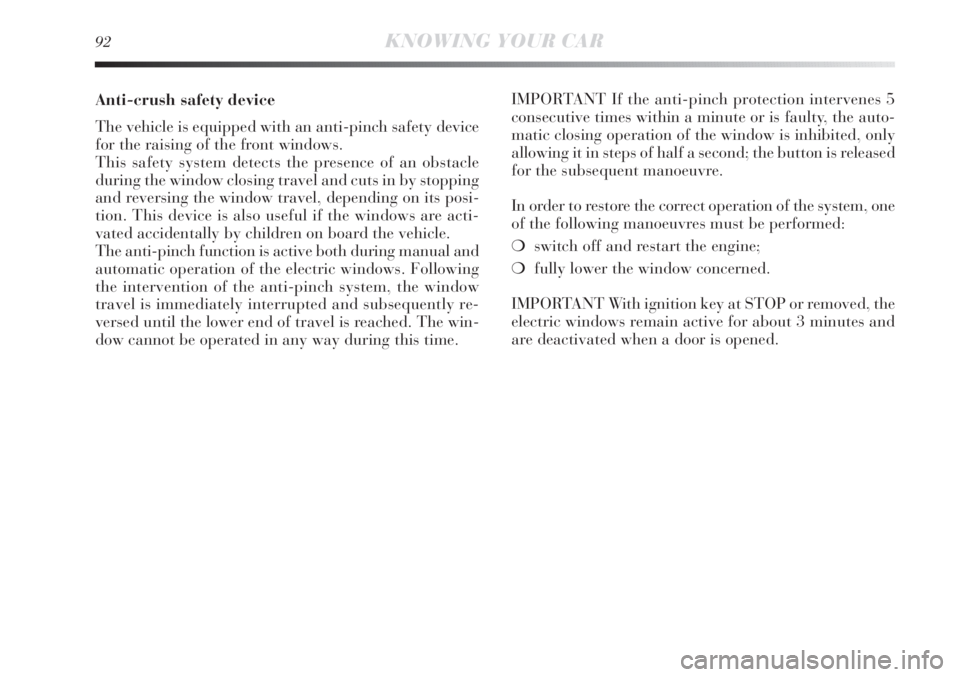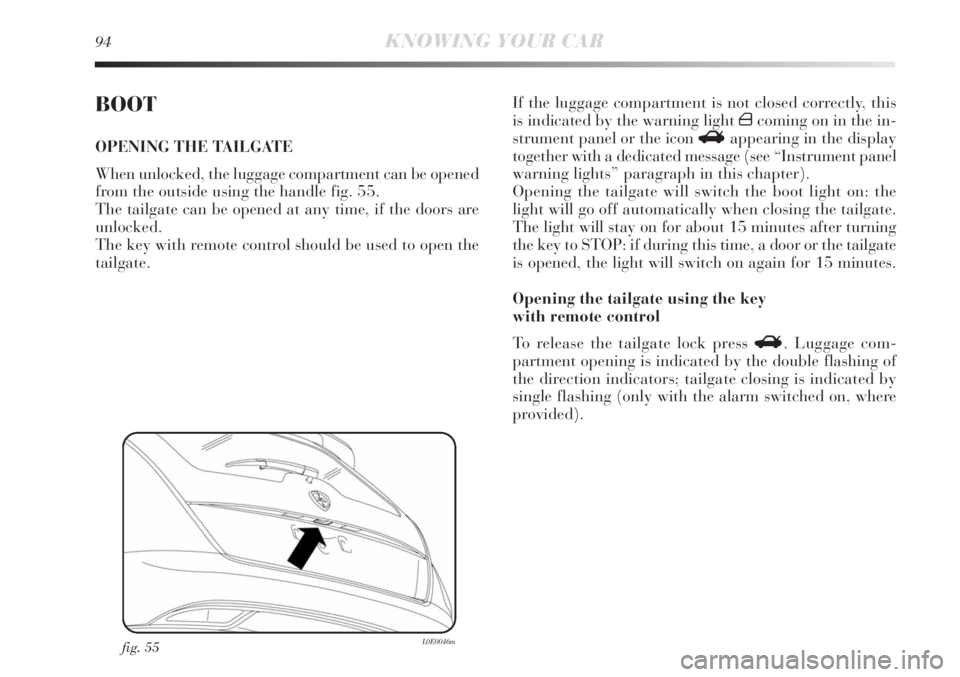Lancia Delta 2013 Owner handbook (in English)
Manufacturer: LANCIA, Model Year: 2013, Model line: Delta, Model: Lancia Delta 2013Pages: 295, PDF Size: 8.29 MB
Page 91 of 295

1
KNOWING YOUR CAR89
The door lock knob can be realigned (only when the bat-
tery charge has been restored) as follows:
ŌØŹpress button
├ŗon the key;
ŌØŹpress door lock/release button
Ōēłin the dashboard;
ŌØŹopen a front door by inserting the key into the key
pawl;
ŌØŹoperate the internal door handle.
fig. 53L0E0291mfig. 53aL0E0290m
EMERGENCY LOCKING DEVICE PASSENGER
SIDE FRONT DOOR AND REAR DOORS
The passenger side front door and the rear doors have a
device to lock them when there is no power.
Proceed as follows:
ŌØŹengage the metal insert of the starting key in position
A - fig. 53 (rear doors) or A - fig. 53a (front passen-
ger side door);
ŌØŹturn the key counter-clockwise and then remove it
from position A - fig. 53 or A - fig. 53a.
Page 92 of 295

90KNOWING YOUR CAR
IMPORTANT If the battery is disconnected or the pro-
tection fuse blows, the luggage compartment opening/
closing mechanism must be initialised as follows:
ŌØŹshut all the doors;
ŌØŹpress button
Áon the key or door lock/release but-
ton
Ōēłin the dashboard;
ŌØŹpress button
├ŗon the key or door lock/release but-
ton
Ōēłin the dashboard.
If the child lock was engaged and the previ-
ously described locking procedure carried
out, operating the internal handle will not
open the door but will only realign the door lock
knobs. To open the door, the outside handle must be
used. The door central locking/unlocking button is
not disabled by the engagement of the emergency
lock
Ōēł.
POWER WINDOWS
These operate when the ignition key is turned to MAR and
for about 2 minutes after turning the key to STOP or re-
moving it.
The control buttons are located in the door panels (the
driver side door panel can be used to operate all the
windows).
An anti-pinch device is operated when the front windows
are lifted.
CONTROLS fig. 54
A. opening/closing left hand front window; ŌĆ£continuous
automaticŌĆØ operation during window opening/closing
stage;
B. opening/closing right hand front window; ŌĆ£continu-
ous automaticŌĆØ operation during window opening/
closing stage;
C. enabling/disabling of rear door electric window con-
trols;
D. opening/closing left hand rear window (for versions/
markets, where provided); ŌĆ£continuous automaticŌĆØ
operation during window opening/closing stage;
E.opening/closing right hand rear window (where pro-
vided); ŌĆ£continuous automaticŌĆØ operation during win-
dow opening/closing stage.
Page 93 of 295

1
KNOWING YOUR CAR91
Press the buttons to open/close the required window.
When one of the two buttons is pressed briefly, the win-
dow moves in stages; if the button is held down, ŌĆ£con-
tinuous automaticŌĆØ operation is activated both for clos-
ing and opening. If the button is pressed again the
window will stop in its current position. Holding the but-
ton pressed for a few seconds will automatically raise or
lower the window (only with key on MAR).
Incorrect use of the power windows may be
dangerous. Before and during operation en-
sure that passengers are not at risk from the
moving glass, either directly or through personal
objects getting caught in the mechanism.
Always remove the ignition key when leav-
ing the car to prevent the electric windows
being operated accidentally and constituting
a danger to the passengers in the car.
fig. 54L0E0045m
Passenger side front door/rear doors
On the passenger side front door control panel, and on
some versions also on the rear doors, buttons F-fig. 54
are provided to control the associated windows.
Page 94 of 295

92KNOWING YOUR CAR
Anti-crush safety device
The vehicle is equipped with an anti-pinch safety device
for the raising of the front windows.
This safety system detects the presence of an obstacle
during the window closing travel and cuts in by stopping
and reversing the window travel, depending on its posi-
tion. This device is also useful if the windows are acti-
vated accidentally by children on board the vehicle.
The anti-pinch function is active both during manual and
automatic operation of the electric windows. Following
the intervention of the anti-pinch system, the window
travel is immediately interrupted and subsequently re-
versed until the lower end of travel is reached. The win-
dow cannot be operated in any way during this time.IMPORTANT If the anti-pinch protection intervenes 5
consecutive times within a minute or is faulty, the auto-
matic closing operation of the window is inhibited, only
allowing it in steps of half a second; the button is released
for the subsequent manoeuvre.
In order to restore the correct operation of the system, one
of the following manoeuvres must be performed:
ŌØŹswitch off and restart the engine;
ŌØŹfully lower the window concerned.
IMPORTANT With ignition key at STOP or removed, the
electric windows remain active for about 3 minutes and
are deactivated when a door is opened.
Page 95 of 295

1
KNOWING YOUR CAR93
Electric window system initialisation
The system must be re-initialised after disconnecting the
battery or if the relevant protection fuse is blown.
Initialisation procedure:
ŌØŹfully close the window to be initialised manually;
ŌØŹonce fully closed, keep holding down the closing con-
trol for at least 1 second.
IMPORTANT Where provided, after there has been no
power supply for the control units (battery replaced or
disconnected or protective fuses for the electric window
control units replaced), the automatic operation of the
windows must be restored.The restoration procedure must be performed as follows
with the doors closed:
1. completely open the driverŌĆÖs door window keeping the
operating button pressed for at least three seconds af-
ter the (lower) end of travel position;
2. completely raise the driverŌĆÖs side window and keep the
button pressed for at least three seconds once the end
of travel position (upper end stop) has been reached;
3. repeat stages 1 and 2 for the passenger-side window
4. make sure that the initialisation is correct by check-
ing that the windows work automatically.
IMPORTANT With central locking on, operating the in-
ternal handle of one of the doors will unlock all the doors.
If there is no electric power supply (fuse blown, battery
disconnected, etc.) it is still possible to operate the door
locking manually; in this case the automatic lowering
function for the windows is not available and to open or
close the door with the window closed it is necessary to
exert pressure on the window towards the inside of the
vehicle to facilitate the movement of the window on the
moulding.
Page 96 of 295

94KNOWING YOUR CAR
BOOT
OPENING THE TAILGATE
When unlocked, the luggage compartment can be opened
from the outside using the handle fig. 55.
The tailgate can be opened at any time, if the doors are
unlocked.
The key with remote control should be used to open the
tailgate.
fig. 55L0E0046m
If the luggage compartment is not closed correctly, this
is indicated by the warning light
┬┤coming on in the in-
strument panel or the icon
Rappearing in the display
together with a dedicated message (see ŌĆ£Instrument panel
warning lightsŌĆØ paragraph in this chapter).
Opening the tailgate will switch the boot light on: the
light will go off automatically when closing the tailgate.
The light will stay on for about 15 minutes after turning
the key to STOP: if during this time, a door or the tailgate
is opened, the light will switch on again for 15 minutes.
Opening the tailgate using the key
with remote control
To release the tailgate lock press R. Luggage com-
partment opening is indicated by the double flashing of
the direction indicators; tailgate closing is indicated by
single flashing (only with the alarm switched on, where
provided).
Page 97 of 295

1
KNOWING YOUR CAR95
CLOSING THE TAILGATE fig. 56
To close, lower the tailgate pressing near the lock until
you hear it click. There are handles B provided inside the
tailgate to allow it to be closed more easily.
fig. 56L0E0047m
If you travel in areas with few filling stations
and you want to transport fuel in a spare
tank, comply with the regulations in force
and use only an approved, suitably secured tank. In
the event of a collision the fire risk is increased all
the same.
Take care not to knock objects on the roof rack
when opening the tailgate.
Never exceed the maximum allowed load in
the luggage compartment; see chapter 6.
Make sure that the objects are well arranged
in the boot so that they will not be projected for-
wards following sudden braking. Never travel with
the tailgate open: exhaust gases may get into the
passengerŌĆÖs compartment.
Page 98 of 295

96KNOWING YOUR CAR
fig. 57L0E0048m
OPENING THE TAILGATE IN AN EMERGENCY
fig. 57
To open the tailgate from the passenger compartment if
the car battery is flat or the electric tailgate lock is faulty,
proceed as follows (see ŌĆ£Extending the bootŌĆØ).
ŌØŹremove the rear head restraints;
ŌØŹfold over the backrests;
ŌØŹoperate lever A to unlock the tailgate mechanically
from inside the luggage compartment.EXTENDING THE BOOT
IMPORTANT If the rear seat backrest is folded down, re-
leasing the rear curtains of the parcel shelf is strictly com-
pulsory (follow the specific indications in the ŌĆ£Parcel
shelfŌĆØ paragraph).
The luggage compartment can be partially (1/3 or 2/3)
or totally extended by splitting the rear seat fig. 58.
Page 99 of 295

1
KNOWING YOUR CAR97
fig. 59L0E0049m
Proceed as follows to extend the luggage compartment:
ŌØŹcompletely lower the rear seat head restraints;
ŌØŹmove the seat belt to the side, making sure that it is
fully extended and not twisted;
ŌØŹrelease the parcel shelf curtain (for versions/markets,
where provided) from the backrests (see the para-
graph ŌĆ£Parcel shelfŌĆØ on the next pages);
ŌØŹoperate one of the levers A-fig. 59 to tilt the desired
seat (to aid this operation, slightly move the seat for-
ward using lever B);
fig. 59L0E0110m
Page 100 of 295

98KNOWING YOUR CAR
To extend the luggage compartment further, the rear seats
can be pushed forwards by operating handle B-fig. 59
(for versions/markets where provided).
IMPORTANT In order to achieve a uniformly flat load
platform, the head restraints should be placed in the fully
extended position before the seats are folded back.
Make sure the backrest is properly secured
at both sides to prevent it moving forward in
the event of sharp braking that may cause
injuries to passengers.
REPOSITIONING THE REAR SEAT
To facilitate the backrest repositioning manoeuvre, it is
helpful to bring the seat cushion completely forward be-
fore folding back the seats.
Move the seat belts to the side, making sure that they are
correctly extended and not twisted.
Press levers A-fig. 59, lift up the backrests and push them
backwards until you hear a click from both attachment
mechanisms. Use handle B-fig. 59 (for versions/markets
where provided) to move the seats back until you hear a
click.